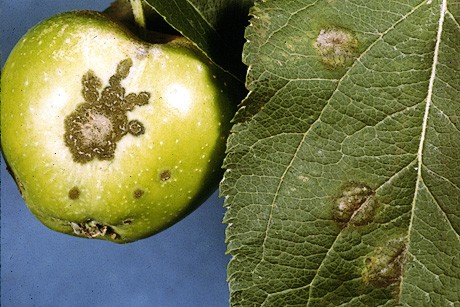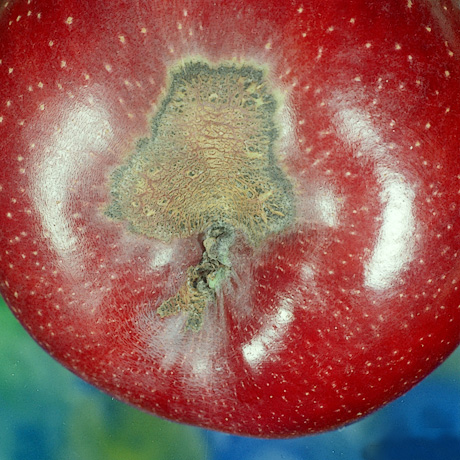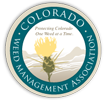
Apple Scab
What is apple scab?
Apple scab is caused by a fungus, Venturia inaequalis, which attacks apple, crabapple, hawthorn, mountain ash, firethorn and loquat trees. It is found wherever apples are found, but is much worse in areas with cool wet spring weather. Apple scab rarely kills apple trees, but will reduce fruit quantity and quality, and heavy damage may weaken trees and make them more susceptible to damage from other causes. It causes the most damage to apple crops of any disease.
 Clemson University - USDA Cooperative Extension Slide Series, Bugwood.org
Clemson University - USDA Cooperative Extension Slide Series, Bugwood.org
How to identify apple scab
Apple scab attacks the leaves, fruit, stems and green twigs, but is most obvious on fruit and leaves. Apple scab spreads two ways, a primary infection when the fungus spreads from debris on the ground to the leaves and fruit of the tree, and a secondary infection when the fungus spreads over the leaf or fruit near the primary infection site.
Primary apple scab infections on leaves start as a few light yellow-green spots, which grow larger and turn olive-green to brown and develop a slightly fuzzy or velvety texture, looking like a "scab". Sometimes the leaves are deformed when the fungus kills some of the leaf cells and the remaining cells grow around the dead area. Secondary infections may spread to cover entire leaf, creating a "sheet scab".
Apple scab infections on fruit, start as a brown or green spot, that grow and become dark brown to black and corky. If young fruits are infected they may become deformed, and fruit with much damage may die and drop from the tree. Apple scab also infects blossoms, starting as small dark green spots on the base of the flower, sepals and stem, and may cause resulting fruit to drop.
 William Jacobi, Colorado State University, Bugwood.org
William Jacobi, Colorado State University, Bugwood.org
Life cycle of apple scab
The Venturia inaequalis fungus, that causes apple scab, lives in the outer layers of living plant tissues, and completely takes over the dead leaves and fruit that fall to the ground. It is very dependent on water availability and temperature to spread infection.
The fungus usually overwinters in dead leaf and fruit debris on the ground. The fungus mates in spring and creates spores that are launched into the air during a rainstorm and carried by the wind and rain to apple trees, this is the primary infection mode of apple scab. This happens about the time the apple trees are blooming, and almost all spores have been launched by 2 weeks after the apple petals fall. The fungus spores require about 9 hours of continuous wetting at 63-75'F for successful germination.
The primary infection sites create more spores that spread to other leaves or fruit for the next 9-30 days depending on temperature and how long the infection site stays wet, this is the secondary infection mode of apple scab. These spores are carried around the leaf or fruit by raindrops or water from irrigation. The secondary infection will continue spreading until the weather dries or the leaves and fruit mature. Young leaves and fruit are most susceptible to apple scab. Leaves are susceptible until they stop expanding. Fruit is most susceptible until about 3 or 4 weeks after petal fall, but will remain slightly susceptible until harvested.
 Clemson University - USDA Cooperative Extension Slide Series, Bugwood.org
Clemson University - USDA Cooperative Extension Slide Series, Bugwood.org
How to control apple scab
Plant varieties of apples and crabapples that are resistant to apple scab and you will greatly reduce the problem. Remove dead leaves from around your apple tree to eliminate the overwintering site of the fungus. Keep irrigation water from getting on leaves and fruit, and water during the day so the leaves and fruit dry quickly. Prune your apple tree to enhance drying of leaves and fruit by increasing sunlight and air flow.
During cool wet spring weather fungicides may be necessary, and the most effective treatment is a preventative fungicide spray early in the spring timed to stop most of the primary infection, when first green is observed in buds until 2 weeks after the apple petals fall.
Curative fungicides are sprayed as soon as apple scab damage is observed. You have 24-96 hours from initial infection to treat. They are absorbed by the apple tree and kill the fungus, preventing any more damage. Spraying fungicide later in the season will reduce secondary infections, but is not as effective as a preventative fungicide spray.
The timing of both primary and secondary infections are very dependent on temperature and wetness, and there are tables that give the best time to apply fungicides based on temperature and length of time the apple tree is wet.
 William Jacobi, Colorado State University, Bugwood.org
William Jacobi, Colorado State University, Bugwood.org
Other resources





